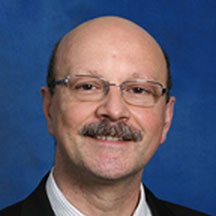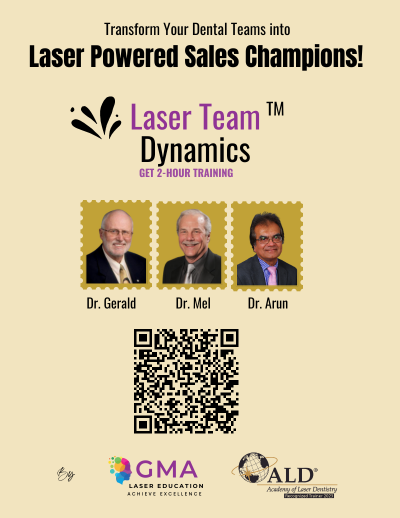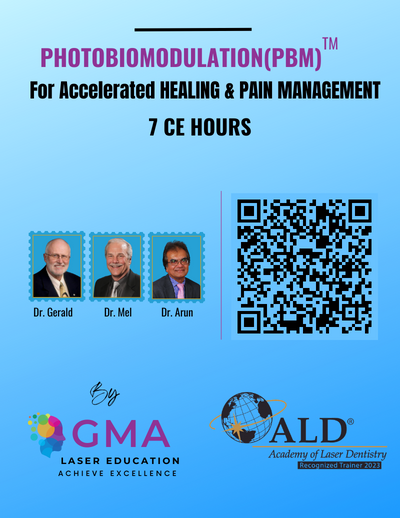ALD LEARNING LIBRARY - PHOTBIOMODULATIONCOVID-19: Speculation on Possible Effects of Photobiomodulation (PBM), James Carroll, AMInstP, FRSM Current Trends in the Treatment of Bacteria Related Periimplantitis Photobiomodulation-Low Level Lasers: The New Secret Weapon in Dentistry COVID-19: Speculation on Possible Effects of Photobiomodulation (PBM)
 No research has been published to-date with PBM on COVID-19 patients, and none is in progress that we are aware of. However, hypothetically there could be some benefits from PBM treatment of symptoms and conceivably improved innate anti-viral immunity. PBM is well known to be immunomodulatory in cell and animal studies though no work has been published specifically on anti-viral immunity in humans or animals. There is encouraging data that PBM reduces the painful symptoms of a herpes zoster infection and herpes simplex eruption, which while interesting these are not respiratory coronavirus infections. What may be more relevant are the anti-inflammatory effects. PBM is a potent antioxidant. It seems to reduce the underlying cause of inflammatory cytokines (including IL-6 a leading player in the cytokine storm), triggering the Acute Respiratory Distress Syndrome (ARDS), the leading cause of death from COVID-19. Evidence from in vivo models of LPS induced ARDS shows that PBM significantly reduces pulmonary and extrapulmonary inflammation. The research shows there are changes in mRNA levels in the genes involved in the apoptotic process and the DNA fragmentation of inflammatory and alveolar cells. No research has been published to-date with PBM on COVID-19 patients, and none is in progress that we are aware of. However, hypothetically there could be some benefits from PBM treatment of symptoms and conceivably improved innate anti-viral immunity. PBM is well known to be immunomodulatory in cell and animal studies though no work has been published specifically on anti-viral immunity in humans or animals. There is encouraging data that PBM reduces the painful symptoms of a herpes zoster infection and herpes simplex eruption, which while interesting these are not respiratory coronavirus infections. What may be more relevant are the anti-inflammatory effects. PBM is a potent antioxidant. It seems to reduce the underlying cause of inflammatory cytokines (including IL-6 a leading player in the cytokine storm), triggering the Acute Respiratory Distress Syndrome (ARDS), the leading cause of death from COVID-19. Evidence from in vivo models of LPS induced ARDS shows that PBM significantly reduces pulmonary and extrapulmonary inflammation. The research shows there are changes in mRNA levels in the genes involved in the apoptotic process and the DNA fragmentation of inflammatory and alveolar cells.
Educational Objectives
Presented April 16, 2020
Current Trends in the Treatment of Bacteria Related Periimplantitis Sebastiano Andreana, DDS, MS
 The presentation will focus on diagnosis and definition of peri-implantitis according to the recent classification. Furthermore, different current clinical protocols will be presented, including the use of different decontaminating agents together with different laser wavelengths. Several clinical scenarios will be showcased. The presentation will focus on diagnosis and definition of peri-implantitis according to the recent classification. Furthermore, different current clinical protocols will be presented, including the use of different decontaminating agents together with different laser wavelengths. Several clinical scenarios will be showcased.
Educational Objectives
Presented May 26, 2020
Photobiomodulation-Low Level Lasers: The New Secret Weapon in Dentistry Gerarld Ross, DDS, Allston, Ontario, Canada
Laser energy has many applications for oral health management including local and systemic influences. These range from post-operative wound healing decreasing reliance on opioid medications to anti-inflammatory effects both centered around photo bio-modulation (PBM). Photo dynamic therapy (PDT) can have dramatic effects on managing microbial disease of the oral cavity without initiating antibiotic resistance.
Educational Objectives
Presented October 2019
ALD Organization Disclosure - Disclaimer on Protocols and Opinions
The views expressed and opinions and materials presented during a presentation represent the personal views and opinions of the individual speakers and do not necessarily represent the views and opinions of the Academy of Laser Dentistry. The Education Committee of the Academy of Laser Dentistry may review content only as it relates to topics within the Curriculum Guidelines and Standards for Dental Laser Education. The Academy of Laser Dentistry assumes no responsibility for the content of the presentations made by individual speakers pertaining to protocols for laser treatment. Any suggested protocols for treatment may be based upon the speakers' own clinical experience and should not be construed as Academy of Laser Dentistry recommended protocols.
|







